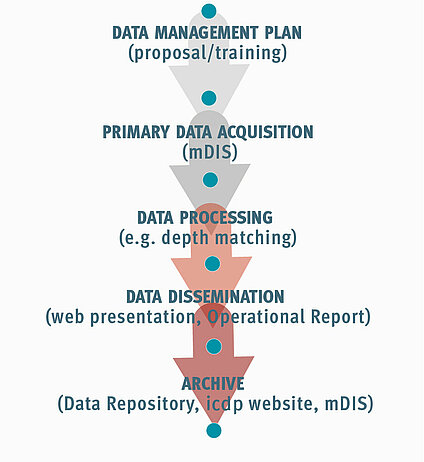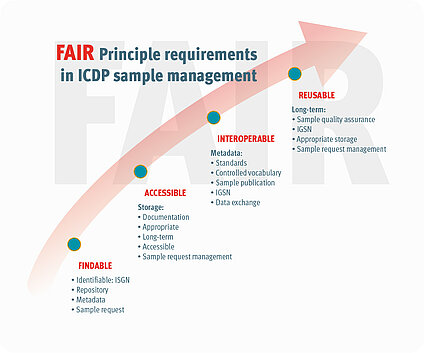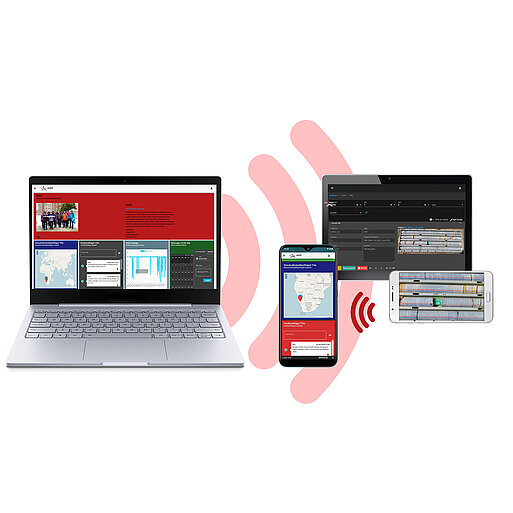icdp Data & Samples
...the foundation for your research
Data and Sample Management for Scientific Drilling Projects must be a comprehensive service in the long term. The main objective is to acquire all information about the technical and scientific works performed during the operational phase in both the field and lab. Well-documented sample material gets prepared for sampling parties and consequent permanent storage. The resulting output provides basic and validated data sets; a common reference indespensible when most of the science team members start their scientific work.
As data is one of the major products of a scientific drilling project, data management is essential for a successful project and potential follow-up operation and publications. It is a long-term task that extends throughout the entire project and deserves a high-level of attention from both the project management and the entire science team. A preliminary Data Management Plan (DMP) should already be outlined in the full project proposal and it should address and document all lifecycle phases of an ICDP project.
All data gathered during the project forms the basis of the Operational Data Set, which is accessible for all science team members during the projects’ drilling and sampling phases as well as for the entire science community after the moratorium period. For data acquisition and sample curation ICDP provides a data management system, the mobile Drilling Information System (mDIS).
Sampling management in ICDP is setup in line with the fair principles (Findability, Accessibility, Interoperability, and Reuseability). While the projects main scientific objectives determine the sampling strategy, the logistics are guided by a sampling plan to secure sample quality, unique sample identification and archiving of the sample material and the related meta data (Operational Data Set). In addition, an early planning of the long-term core and sample preservation and storage is crucial to guarantee the long-lasting success of a project.
The finalization of the sampling plan and the core handling are topics of the training course on data and sample management, provided by ICDP-OSG 3 - 6 month ahead of the operation phase of each approved ICDP drilling project.
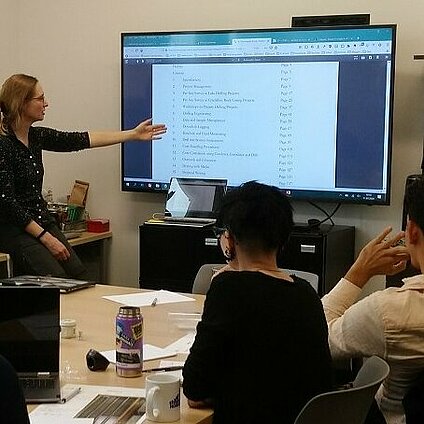
For all ICDP drilling projects the data and sample management training is mandatory and costs should be part of the budget plan. More details are available in the ICDP Primer, a best practice brochure.
Within the training course the data and sample management cycles, the details for data acquisition, core handling procedures and on-site workflows will be discussed and developed. The data acquisition tool used in all ICDP projects, the mobile Drilling Information System (mDIS), will be presented and adapted for the specific requirements of the project.
The list of participants should include at least one PI and a person responsible for the data and sample management in the field and in the laboratory (if applicable). Commonly, 3 – 5 on-site science team members complete the list of participants to support the implementation of the onsite sample workflow. It is preferential, if at least the data manager has some skills in computer handling and data acquisition. It is intended that the data manager provides guidance and education of additional staff entering data, oversees consistency and quality of the data acquisition and functions as relay for distributing reports.
The mobile Drilling Information System (mDIS) is a database management application developed and provided by ICDP for capturing and curating meta data on geological cores and samples, drilling progress, and lithology. In addition, images, surveying logs and driller reports are collected. During the operational phase, data reports and sample labels support curating and archiving of the samples. Following the operational phase, mDIS contains the basic data set, which needs to be compiled in the Operational Data Set & Report.
mDIS will be deployed and adapted during the mandatory data and sample management course with the possibility for remote follow-up training and online support during the field operation. It is designed to be used onsite in parallel with daily operations to perform the centralized data acquisition alongside a defined workflow.

The mDIS structure is hierarchical and reflects the ICDP naming conventions. It starts with program as highest hierarchy level, followed by expedition, site, hole, core, section, sample, etc. levels. Each hierarchy level is defined by a data table and an entry mask (form), which can be customized by trained users for project specific needs.
Data to be inserted includes all drilling and sample relevant information including the technical drilling parameters, core data, core scans, lithological description, photos and initial measurements. In the relational database, data integrity is enforced with respect to data formats and naming conventions. Further, mDIS automatically assigns International Geo Sample Numbers.
Once the data is stored it is possible to print labels including a QR code and data reports that can easily be transferred into external data-processing applications and spreadsheets.
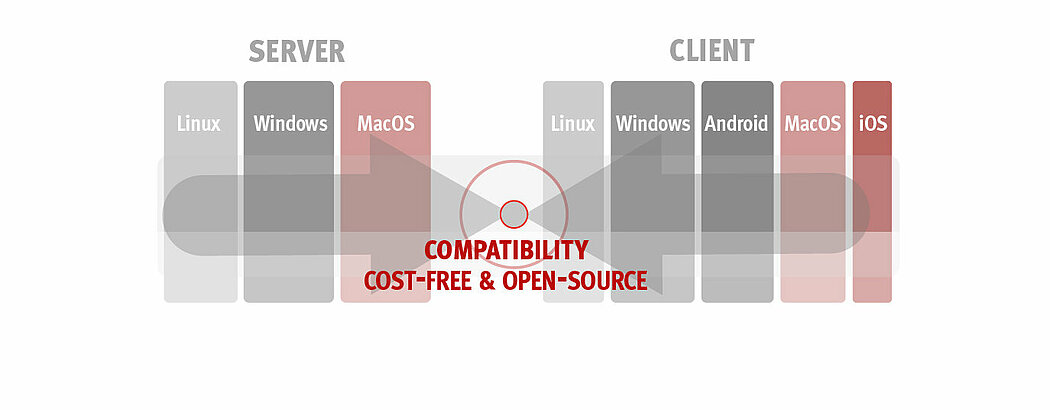
mDIS is a platform independent, responsive and open source (GPL 2.0) data management system. It is set up in a server-client environment and is available as a standalone version or as a web application. The standalone version is useful for data entry in remote areas without internet access. The web application is used, if internet is available and data acquisition is done on several computers and at different locations,
The native mDIS runs on Linux, but deployed as a virtual box instance it can be installed on Windows, Mac and Linux systems and contains the data base system and the mDIS application. mDIS is then accessed via a web browser to view, update, edit or upload data.
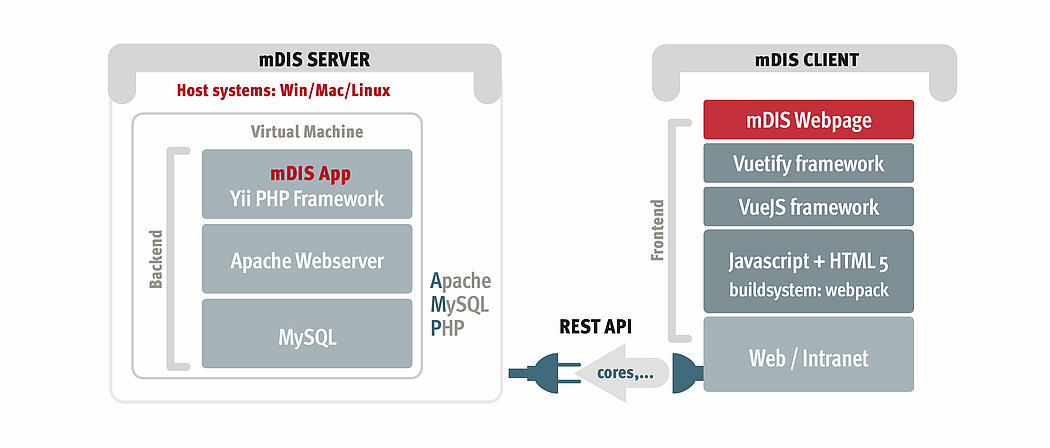
Technically, mDIS is a relational database backed web application built on a LAMP stack (Linux, Apache, MariaDB, PHP). On the client side, mDIS is based on a Javascript framework (VueJS) that, in conjunction with the Yii PHP framework, allows for reactive two-way data binding. On mobile devices, mDIS can run as a Progressive Web App (PWA), which works almost like a native app. mDIS has REST application programming interfaces (APIs) for third-party application developers and external data providers. These APIs can be used for importing data from legacy DIS installations and other data sources such as text files and collections of core imagery.
ICDP Primer Chapter 4.3: Data Management (PDF)
ICDP Primer Chapter 4.4 & 4.5: Sample Management (PDF)
Behrends, K.; Heeschen, K.; Kunkel, C.; Conze, R.; 2020, The mobile Drilling Information System (mDIS) for core repositories, EGU General Assembly 2020.
Behrends, K.; Conze, R.; Hörner, T.; Alali, O.; Reckert, R., Lorenz, H.; 2019, ICDP's Drilling Information System goes Mobile (mDIS), EGU General Assemby 2019.
Conze, R.; Lorenz, H.; Ulbricht, D.; Elger, K.; Gorgas, T.; 2017, Utilizing the International Geo Sample Number Concept in Continental Scientific Drilling During ICDP Expedition COSC-1: Data Science Journal, v. 16, no. 2, p. 1-8.

